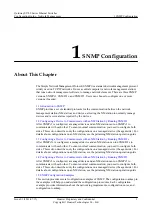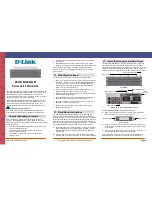
NOTE
When multiple NM stations using different SNMP versions manage the same device in a network,
SNMPv1, SNMPv2c, and SNMPv3 can all be configured on the device for its communication with all the
NM stations.
Table 1-2
Description of features supported by SNMP
Feature
Description
Access control
This function is used to restrict a user's device
administration rights. It gives specific users
the rights to manage specified objects on
devices and therefore provides fine
management.
Authentication and encryption
Packets transmitted between the NM station
and managed devices are authenticated and
encrypted. This prevents data packets from
being intercepted or modified, improving
data sending security.
Error code
Error codes are used to identify particular
faults. They help an administrator quickly
locate and rectify faults. The larger the variety
of error codes, the more greatly they help an
administrator in device management.
Trap
Traps are sent from managed devices to the
NM station. These traps allow an
administrator to discover device faults
immediately.
The managed devices do not require the
acknowledgement from the NM station after
sending traps.
Inform
Informs are sent from managed devices to the
NM station.
The managed devices require the
acknowledgement from the NM station after
sending informs. If a managed device does
not receive an acknowledgement after
sending an inform, it will resend the inform
to the NM station and generate alarm logs.
Even if the NM station restarts, it can still
synchronize the informs sent during the
restart process.
If the device does not receive an
acknowledgement from the NM station after
sending an inform, it will store the inform in
its memory. In this regard, using informs may
consume lots of system resources.
Quidway S2700 Series Ethernet Switches
Configuration Guide - Network Management
1 SNMP Configuration
Issue 01 (2011-07-15)
Huawei Proprietary and Confidential
Copyright © Huawei Technologies Co., Ltd.
5
















































